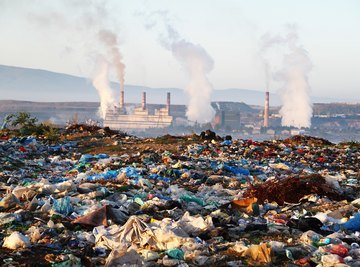
Land pollutants can be solid, liquid or gaseous. They deteriorate the quality and mineral content of soil and disturb the biological balance of organisms in the soil. Causes of land pollution include an increase in urbanization, domestic waste, dumping industrial waste on land and improper agricultural activities. You can prevent land pollution by minimizing or eliminating waste at the source and substituting nontoxic options for hazardous materials.
Reducing Chemical Fertilizers and Pesticides
Plants require soil nutrients such as nitrogen, calcium and phosphorous for growth and development. Also, crops come under attack from rodents, insects and bacteria, so farmers require pesticides to protect the plants.
The use of fertilizers and pesticides in agriculture, however, leads to other problems. Some raw materials can contaminate the soil. For instance, copper and boron in fertilizers, and organochlorine in pesticides, can harm the environment and create health risks when products are used in wrong proportions or over a long period of time.
To prevent such damage, farmers should use composted manure and bio-fertilizers -- biologically active products such as algae and bacteria that can help initiate nitrogen fixation in soil. Biological methods of pest control such as importation – introducing a pest’s natural enemy in a location where they do not naturally occur — also minimize soil pollution.
Reforesting
Forests and grassland vegetation bind soil to keep it intact and healthy. They also support many habitats that contribute to a complete ecosystem. Construction, cutting of timber and mining, on the other hand, leave the soil bare and expose land to contaminants. Restoring forests by planting more trees protects the land from floods and soil erosion. It also improves the fertility of the land and increases biodiversity.
Solid Waste Treatment
Dumping solid waste such as domestic refuse, garbage and industrial materials on land increases the level of toxicity and hazardous substances in soil. Waste also alters the chemical and biological properties of soil such as its alkalinity levels. Through chemical treatment methods such as acid-base neutralization, municipalities can alter the pH level of solid waste before dumping it in landfills. Degrading insoluble waste by using methods such as adding chemicals or enzymes under a controlled environment before disposing of it also reduces land pollution.
Recovering and Recycling Material
To reduce solid waste pollution on land, you can reuse materials such as cloth, plastic bags and glass in your home rather than disposing of them. By recycling, you reduce the amount of solid refuse going to landfills and also make a contribution toward saving natural resources. For example, according to the U.S. Environmental Protection Agency, when a company recycles 1 ton of paper, it saves an equivalent of 17 trees.
References
- U.S. Environmental Protection Agency: Pollution Prevention
- Marine Organic Farmers and Gardeners Association: Basics of Organic Soil Fertility
- National Center for Biotechnology Information: Impact of Pesticides Use in Agriculture: Their Benefits and Hazards
- University of California Agriculture and Natural Resources: Biological Control and Natural Enemies
About the Author
Mike Stephen began writing professionally in 2004. He specializes in articles related to science, health and nutrition. He served as an editor for online special-needs magazines and currently writes about science, nutrition and music for several publications.
